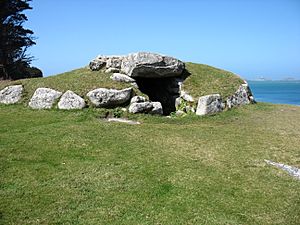Innisidgen facts for kids
Quick facts for kids Innisidgen |
|
|---|---|

Lower entrance Grave at Inisidgen
|
|
| Location | St Mary's, Isles of Scilly |
| Built | Bronze Age |
| Lua error in Module:Location_map at line 420: attempt to index field 'wikibase' (a nil value). | |
Innisidgen is a special place on the island of St Mary's. It is home to two ancient burial sites from the Bronze Age. These sites are called entrance graves.
The two graves are known as Upper and Lower Innisidgen. They are found on a steep part of Innisidgen Hill. From here, you can look out over Crow Sound towards the Eastern Isles.
Contents
Exploring Innisidgen Hill
Innisidgen Hill is a protected historical site on the Isles of Scilly. It is located northeast of Hugh Town, the biggest village on St. Mary's. This hill is famous for its two Bronze Age entrance graves. They offer amazing views of Crow Sound and the Eastern Isles.
Innisidgen Hill is also close to the small village of Trenoweth. The larger burial chamber, called "Upper Innisidgen," sits right on top of the hill. The smaller grave, "Lower Innisidgen," is on the lower northern side. There are also some old remains from the English Civil War here.
Lower Innisidgen Grave
The Lower Innisidgen grave is found near the bottom of Innisidgen Hill's northern slope. This grave is more damaged than the one higher up. It only has two of its original roof stones, called capstones. Some parts of the stone edge around the mound are still there. The mound itself includes small bits of natural rock sticking out.
This entrance grave is a round mound of earth and stones. It is about 8.5 meters (28 feet) wide and 1.7 meters (5.6 feet) tall. Inside the mound is a central room, or chamber. This chamber is 5.4 meters (17.7 feet) long, 1.3 meters (4.3 feet) wide, and 1 meter (3.3 feet) high. The entrance to this room faces north. The walls of the burial chamber are made of stacked stones. A large stone sits at the northern end of the chamber. Big flat stones line parts of the east wall. Two capstones form the roof over the middle and southern parts of the chamber. In 1950, someone dug into the chamber without permission and removed the earth and stones inside.
Upper Innisidgen Grave
The Upper Innisidgen grave is also known as "The Giant's Grave." It is one of the best-preserved entrance graves on the Scilly islands. This grave is a slightly oval mound of earth and stones. It measures about 9 meters (30 feet) by 8 meters (26 feet) and is 1.8 meters (5.9 feet) tall. The stone edge around the mound is about 1 meter (3.3 feet) high on its north side. There are also hints of an outer platform, up to 2 meters (6.6 feet) wide.
The top surface of the grave is covered in grass. The mound covers a burial chamber that is still complete. The entrance to this chamber is on the eastern side of the mound. A large stone slab covers the entrance. The chamber itself is rectangular. It is 4.6 meters (15 feet) long, about 1.5 meters (4.9 feet) wide, and 1.2 meters (3.9 feet) high. The walls of the chamber are lined with large stone slabs. Along the north-northeast wall, there are smaller stacked stones and rubble. A large stone slab blocks the west-northwest end of the chamber. Five large slabs form the roof of this burial chamber. You can see parts of these roof slabs poking out of the grassy mound.
History of the Graves
The Isles of Scilly were first settled a very long time ago, around 2500 BC. This was during the Neolithic period. Burial sites on the islands were built from the later Neolithic period to the Middle Bronze Age (around 2500-1000 BC).
Entrance graves are special because of how their burial chambers are built. They often have walls made of large upright slabs, stacked stones, or both. Big flat stones usually form the roof. You can usually get into the chamber through an opening in the stone edge of the mound. When archaeologists have dug into other entrance graves, they have often found cremation urns (pots holding ashes), pieces of pottery, and human bones (both burned and unburned).
The two entrance graves at Innisidgen Hill were built during the Bronze Age. When they were first made, these burial chambers looked out over a coastal area called Crow Sound. In prehistoric times, this area would have been a wide valley with fields. These fields were enclosed by stone walls. You can still see the remains of an ancient field system on the northern slope of Innisidgen hill, right next to the graves. They look like mounds of earth and piles of stones. When both graves were first dug up in 1854, no artifacts or human remains were found inside them.


